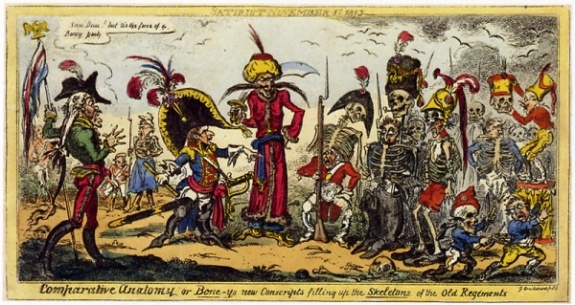False Splendor
 As the most powerful monarch of Europe with great military ambitions for France, the “Sun King” Louis XIV (r. 1643-1715) did not lack for enemies. His detractors in Britain, the Holy Roman Empire and the Dutch Republic – some of them French Huguenots who had fled the Catholic regime of their home country – were keen to attack the splendorous image Louis projected. Pamphlets were published with titles such as Eigenlob stinkt gern [“Self-praise loves to smell”] and Laus Ludovici Delusa [“In praise of Louis the Delusional”]. The Dutch artist Romeyn de Hooghe turned the image of the Sun King upside down by portraying Louis as Phaethon, the son of Helios, whose foolish efforts to steer the chariot of the sun across the heavens resulted in calamity and his untimely death.
As the most powerful monarch of Europe with great military ambitions for France, the “Sun King” Louis XIV (r. 1643-1715) did not lack for enemies. His detractors in Britain, the Holy Roman Empire and the Dutch Republic – some of them French Huguenots who had fled the Catholic regime of their home country – were keen to attack the splendorous image Louis projected. Pamphlets were published with titles such as Eigenlob stinkt gern [“Self-praise loves to smell”] and Laus Ludovici Delusa [“In praise of Louis the Delusional”]. The Dutch artist Romeyn de Hooghe turned the image of the Sun King upside down by portraying Louis as Phaethon, the son of Helios, whose foolish efforts to steer the chariot of the sun across the heavens resulted in calamity and his untimely death.
However, the most memorable attack against Louis’s royal aura was published long after his death, in the form of a cartoon by the nineteenth-century British satirist William Thackeray. Without his splendid dress and attributes, it turned out, the Sun King was just a measly little man with a bald head.
Literature
• Friedrich Kleyser, Der Flugschriftenkampf gegen Ludwig XIV. zur Zeit des pfälzischen Krieges (Berlin 1935)
• Pieter van Malssen, Louis XIV d’après les pamphlets répandus en Hollande (Amsterdam 1936)
• Peter Burke, The Fabrication of Louis XIV (New Haven – London 1992)




